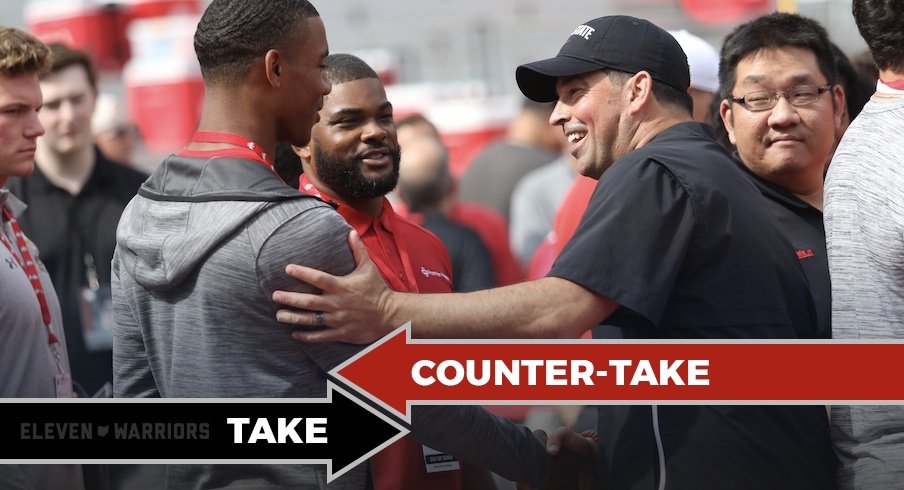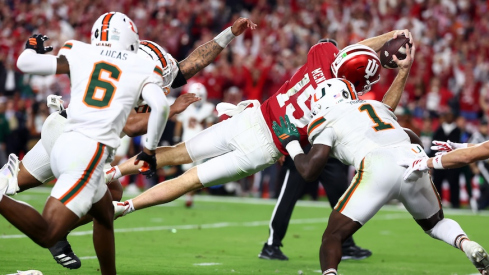There wouldn't seem to be much to debate about regarding Ohio State's current recruiting successes.
While already maintaining a stranglehold on the No. 1 recruiting class in the 2021 cycle, provided Ryan Day and his staff finish strong, the Buckeyes could make a run at the best class in the modern recruiting era. That isn't hyperbole, either. They hold 19 commitments, and by securing the top remaining targets on their board, they'd top Florida's 2010 class, which holds the crown.
But we're tackling a long-debated recruiting question anyway. Should the Buckeyes prioritize recruiting prospects from Ohio?
Take: Ohio State Should Prioritize In-State Prospects
Colin Hass-Hill: My name isn’t Jim Tressel. I’m not here to advocate that Mark Pantoni enters his quarantine bunker, pulls up the 247Sports composite rankings on his laptop, click on the Ohio rankings, then copy and paste the 25 best players in state onto Ohio State’s recruiting board.
Let’s be realistic. Ohio State doesn’t become Ohio State without thriving nationally on the trail. Dwayne Haskins, Jeff Okudah, Chase Young, J.T. Barrett, the Bosa brothers, Justin Fields, TreVeyon Henderson, Chris Olave and Raekwon McMillan just popped their heads in here to say hello.
But, for a multitude of reasons that I’m sure my friend and colleague Kevin Harrish doesn’t want you to believe, it’s important for the Buckeyes to prioritize Ohio-based prospects in recruiting.
For Ohio State, Ohio has to be the bedrock. The foundation upon what everything is built.
“It will continue to be our first priority to recruit Ohio football players,” Ryan Day said at his introductory press conference as the Buckeyes head coach.
Of course, that’s the cheapest way for any newly hired coach anywhere to get applause from the local fans. Chris Holtmann made a similar move three years ago, saying the new basketball staff was working to “close the borders and dominate the state of Ohio in recruiting.” But it also matters that Day executes those words.
Really, that message is the basis of how Pantoni and Day have been executing the program’s recruiting strategy that has them trending toward potentially what’ll be the best class in the modern recruiting era.
In the 2021 cycle, they landed Pickerington North five-star defensive end Jack Sawyer nearly two years before signing day. That summer, Revere's Ben Christman and Massillon Washington’s Jayden Ballard committed, then Ironton’s Reid Carrico pulled the trigger in September. The early commitments allowed the Buckeyes to chase national prospects and while being choosy with the rest of the in-state recruits while knowing they’d already secured four of the top-five Ohio prospects.
By March, Ohio State added commitments from Cleveland Heights’ Mike Hall, La Salle’s Devonta Smith and La Salle’s Jaylen Johnson to the country's No. 1 class.
The inside-out strategy of prioritizing Ohio as early as possible, thus allowing the coaching staff to secure the best in-state prospects as early as possible and maximize the amount of time spent on out-of-state recruits, has continued into the 2022 cycle. Already, Day’s staff has received pledges from West Chester’s Tegra Tshabola and Archbishop Alter’s C.J. Hicks, both of whom are ranked among the three best Ohioans. Ohio State’s also the leader for Marysville’s Gabe Powers, the state’s top 2022 prospect.
By ensuring they lock down Ohio’s best prospects as soon as possible, the Buckeyes both take advantage of being located in the most talent-rich state in the midwest and cut off competing programs from picking off talented players they want. Where do the top players in Ohio go if they don’t end up in Columbus? Notre Dame, Michigan, Michigan State and Kentucky, usually.
For Ohio State to make things tougher on competing programs located in the region, they have to prioritize Ohio – and it has worked.
Urban Meyer recently told the Toledo Blade he doesn’t “feel the street fight at all” with Michigan over Ohio recruits. The Wolverines wouldn’t have employed the wave-the-white-flag strategy of recruiting Ohio if the Buckeyes were leaving them an opening. But by dominating the state, they’ve led Jim Harbaugh to look elsewhere, avoiding head-to-head recruiting battles with Ohio State.
The prioritization of Ohio also helps balance the roster out.
If Ohio State’s getting a three-star prospect, it might as well be a three-star from the state. Between the 2010 and 2016 recruiting cycles, Ohio State signed 51 three-star prospects, with 26 being from Ohio and 25 coming to Columbus from out of the state. Of the Ohioans, 17 either stayed at Ohio State for the duration of their eligibility or left early for the NFL draft. Comparatively, only eight out-of-state three-stars played out their college careers as Buckeyes.
“At Ohio State, the right balance of young, talented guys like Dwayne Haskins or Chase Young or Jeff Okudah, who they're only going to be here for three years, mixed in with fourth- and fifth-year seniors who are veterans, been around the program with great leadership and maturity,” Day said in April. “This year, we have Justin Hilliard and Jonathon Cooper. We're hoping to hear about C.J. Saunders.”
All three of them? Ohioans. So, too, are fellow senior starters Thayer Munford and Luke Farrell.
It's not as if Ohio isn't home to studs, either. Zach Harrison, Paris Johnson, Josh Myers, Jerome Baker, Marshon Lattimore and Dre'Mont Jones say otherwise.
The Buckeyes shouldn’t just recruit Ohio hard because they feel obligated, and they shouldn't only go after high schoolers from within the state's border. That would be ridiculous, and no one would argue that. A national presence clearly matters. But Ohio State should prioritize in-state recruits, too, in order to stay on top.
Now, go listen to Kevin Harrish, a noted Georgia native and resident, tell you why recruiting Ohio doesn't matter.
Counter-Take: Ohio State Should Not Prioritize In-State Prospects
Kevin Harrish: I’m not anti-Ohio, but I am pro-winning. And I boldly believe that the best way to win is to collect the best players. My argument is simply that Buckeyes should do that.
When it comes to recruiting, signing the most talented players in the country should be Ohio State’s only concern. It simply should not matter where those players come from. Priority should be given to the better player, regardless of home state.
It’s a heartwarming story every time a local kid gets to suit up in the Scarlet and Gray after dreaming of playing for the Buckeyes as a kid, but the reality is Ohio State isn’t the Make-A-Wish Foundation, it’s a program that expects to compete for a national title every season, and a national recruiting approach is a tried-and-true way to make that happen.
If you’d like proof, look at Alabama, which has been the most dominant program of the last decade because of its national recruiting approach.
The Crimson Tide signed the nation’s best class every single season for seven years between 2011 and 2017 and won four national titles with two runner-up finishes during that span. They also signed no more than eight prospects from their home class in each recruiting class. During that same span, Ohio State signed nine or more Ohioans in every single class, never had the nation’s highest-rated recruiting class and won a single national title.
Now, the obvious difference is that Ohio is a more populous state that produces more elite football talent. But the fact remains that Alabama does not tie itself to in-state loyalties and has found unprecedented success as a result.
And we can’t pretend like Ohio State hasn’t already benefitted from a national recruiting approach. Taking the past 10 classes that had at least three years to develop (I.e. from 2008 to 2017), Ohio State signed 121 players from Ohio and 119 from elsewhere – a near-even split. But out of those classes, there were more than twice times as many All-Americans from other states (13) as there were from Ohio (6), and twice as many first-round picks, as well.
If you’re a fan of recruiting rankings, we can talk those, too. Ohio State’s two highest-rated classes in the recruiting rankings era (2017 and 2018) had the lowest percentage of in-state signees. On the other end of the spectrum, Urban Meyer’s two lowest-rated recruiting classes at Ohio State – 2012 and 2015 – had the highest percentage of in-state signees.
The numbers are pretty clear which recruiting strategy pays off, regardless of both Urban Meyer and Ryan Day publicly voicing their desire to recruit Ohio harder (and then never actually doing it – for good reason).
I’m not suggesting the Buckeyes should completely neglect the state of Ohio in recruiting, but I do think they should be more careful which in-state prospects they choose to sign. Ohio is a talent-rich hotbed for high school football and it would be unwise to ignore players like Braxton Miller, Jalin Marshall, Zach Harrison or Jack Sawyer, but they are also some of the best players in the country, and that should be the standard.
I don’t want Ohio State to stop recruiting the state of Ohio, I simply want Ohio State to prioritize recruiting the best players in the country that deserve to play for one of the best programs in the country. If they do that, I’m optimistic that there will be plenty of Ohio prospects, anyway.


